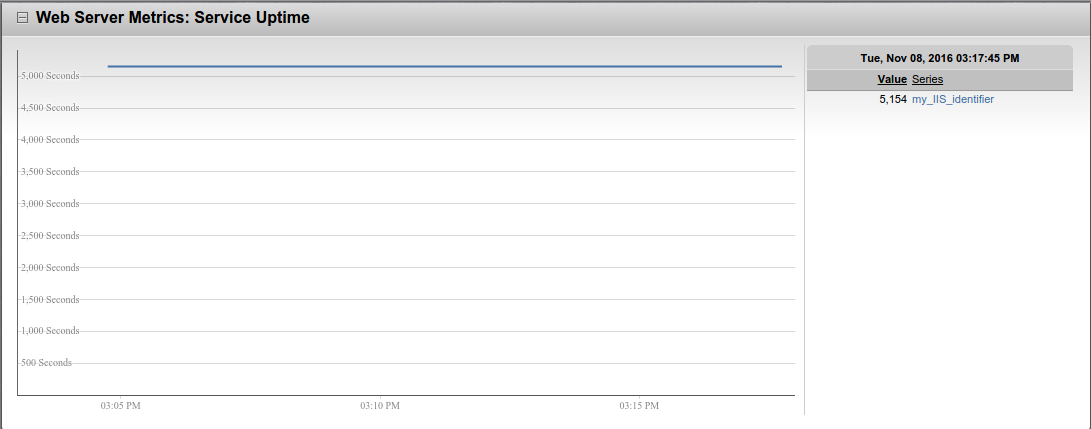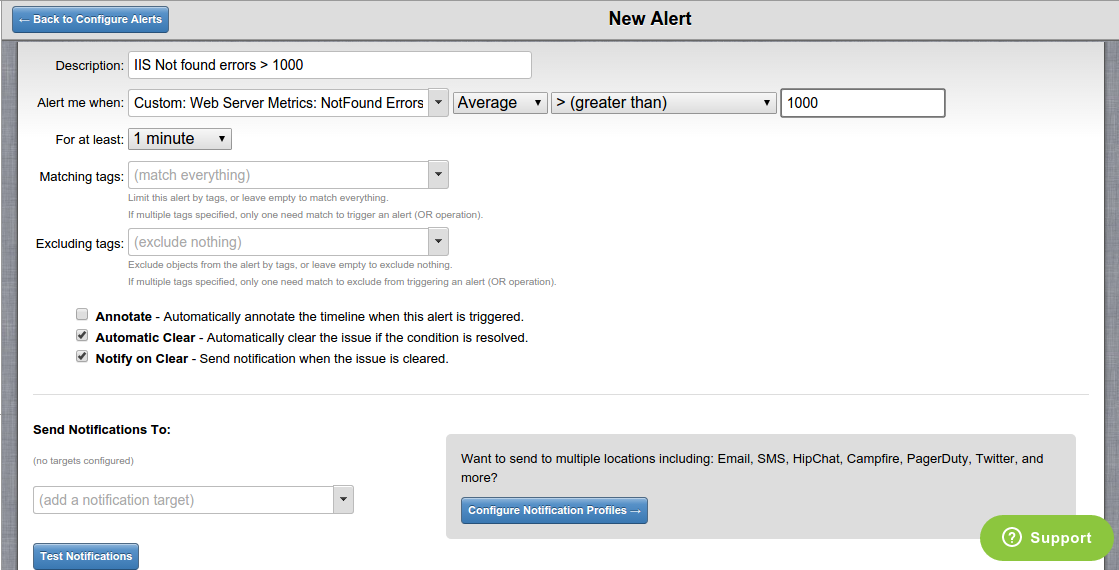Monitor a Microsoft IIS Server
Are you are using an IIS Server to render your web application?
You might be interested in monitoring your IIS Server for availability and performance using IDERA Uptime Cloud Monitor.
As an illustration, you can configure and receive alerts for the following scenarios:
- Availability: If the service uptime metric goes to zero, you will receive an alert that the IIS Server is no longer available.
- Performance:
- If the current connections metric exceeds a threshold, you will be alerted that the IIS Server is under high load.
- If the locked errors exceeds a threshold or if the bytes sent/ sec falls below the expected range, you will be alerted that the IIS Server is not performing optimally.
The full set of metrics monitored from an IIS Server instance is listed here. You can configure and receive alerts on any of these metrics.
Prerequisites
Uptime Cloud Monitor from IDERA offers a SAAS based out-of-the-box solution for monitoring a Microsoft IIS Server instance for availability and performance. If you are not familiar with the concept of custom metrics as used in Uptime Cloud Monitor, please go through this appendix once before continuing with this document.
- Login to your Uptime Cloud Monitor account
If you don’t already have an account, sign up for a 14 day FREE TRIAL of Uptime Cloud Monitor (no Credit Card required)
- IIS Server is up and running
- Admin access to the Server instance to install the Custom Metrics Monitoring Agent.

Figure 1: The Basic Architecture of the IIS Server Monitoring Setup
The Custom Metric Agent for IIS Monitoring will be installed on your Microsoft IIS Server. Once this setup is completed, the Custom Metrics Agent will regularly collect performance & availability metrics from the monitored IIS Server and upload those metrics to your IDERA Uptime Cloud Monitor Account. If any performance issues arise, an alert will be triggered and you will be notified about it immediately.
Use IDERA Uptime Cloud Monitor to monitor your Microsoft IIS Server
There are three steps that you need to do to start monitoring a IIS Server using IDERA Uptime Cloud Monitor:
- Custom Metrics Agent Installation to monitor the IIS Server
- Verify that your IIS Monitoring Dashboard is up and running
- Configure alerts to be notified about IIS Server availability & performance issues
Step 1: Custom Metrics Agent Installation to monitor the IIS Server

Figure 2: Navigate to Custom Tab -> Getting Started inside IDERA Uptime Cloud Monitor

Login to your UCM account and navigate to Custom tab -> Getting Started. Click on Microsoft IIS icon displayed above.

Figure 3: The installer script for the Custom Metrics Agent for IIS Monitoring
- Click on
 icon to copy the installer script to your clipboard.
icon to copy the installer script to your clipboard. - Open Powershell terminal window on the server where you want to install the agent. NOTE: This installer script can also be run on another server which is connected to the IIS Server to be monitored.
- Paste the command copied above into the Powershell window and press <return> to run the script
- As soon as the script starts running on a terminal with root access, it starts downloading the required Custom Metrics Agent for IIS monitoring. You will need to configure the following items in the agent installation process. Item specified in square brackets ( [ ] ) are the default. Just hit <return> to select the defaults

Figure 4: Executing the Custom Metrics Agent installation powershell script for IIS Server Monitoring
- Monitoring frequency (sample rate; in seconds): [60]
- Set values for the IIS Metrics:
- Custom Metrics group name: [IIS]
- Custom Metrics group label: [Web Server Metrics]
- Dashboard name: [Microsoft Web Server]
- Set the Unique name for this IIS server instance: [Instance]
- Set the Servername (name of our Windows Server instance): [WIN-F9F0CSEP961]
Step 2: Verify that your IIS Monitoring Dashboard is up and running
Navigate to Dashboards tab and you will see a new IIS Monitoring Dashboard titled “Microsoft Web Server” has been added automatically by the installer.
Some of the metrics you will see in these Dashboards are listed below:

Figure 5: The IIS Monitoring Dashboard displays the Uptime value

Figure 6: The IIS Monitoring Dashboard displays the count of current users
Monitored metrics
The complete set of metrics being tracked for the IIS Server is shown below. You can see the same by navigating to the Custom Tab > Custom Objects and selecting Details on the Custom Metrics Group Label [Web Server Metrics] that was given as installation input.

Figure 7: The complete set of metrics being tracked for the IIS Server
Step 3: Configure Alerts to be notified about IIS Server Availability and performance issues

Figure 8: A new alert being added that will be triggered when NotFound Errors are more than a threshold (1000 here)
You can configure new alerts that will be triggered when performance issues with the IIS Server arise. You can also configure the notification mechanisms for a triggered alert.
- Go to Alerts Tab > Configure alerts and click on “New Alerts” button
- Provide values for these fields in the New Alert page:
- Description: A description of the alert that will be easily recognized by you and your team if the alert is triggered
- Alert me when: Select the metric of interest and the condition upon which the alert is triggered. In the Alert me when dropdown, you can prefill “Custom: <your IIS Server Group Label>” to get only the set of relevant metrics for configuring alerts for your IIS Server instance. In Figure 8, the chosen metric of interest is Not Found Errors from the Web Server Metrics group and the condition for triggering the alert is if the average value is more than 1000
- For at least: The duration for which the alert condition must be valid for the alert to be triggered
- Matching tags: By default, (match everything) is chosen. If needed, you can attach tags to a particular metric object and select those tags here, which would cause only alerts on that metric object to be triggered.
- Excluding tags: By default, (exclude nothing) is chosen. If needed, you can attach tags to a particular metric object and select those tags here, which would cause alerts on that metric object to be skipped.
- Annotate: When enabled, an annotation is automatically created when the alert is triggered. Annotations will be visible in the custom metrics dashboard where the data stream is displayed.
- Automatic Clear: When enabled, the alert issue is automatically cleared if the triggering condition is no longer true
- Notify on clear: When enabled, notifications are also sent when the alert issue is cleared. Please do note that notifications are always sent when the alert issue is triggered.
- Send Notifications To: Here you can configure the notification mechanisms by which the alert is communicated to you and others in your team.
Uptime Cloud Monitor supports notifying different sets of users with differing notification mechanisms for each alert type.
Notification mechanisms include:
- SMS
- PagerDuty
- HipChat
- Campfire
Webhooks are also exposed for clients to configure custom notification mechanisms.
More about setting up website probe alerts can be found here.
Free Trial!
Sign up for a 14 day FREE TRIAL of Uptime Cloud Monitor (no Credit Card required).
You can find more information about Uptime Cloud Monitor pricing options here.
We charge only $0.08 per month per metric!
Sign up today!
Appendix: A Quick Note on Custom Metrics
Custom Metrics supports monitoring of data samples from any source (hence the name ‘custom’) that are sent as input using simple CURL requests.

Figure 9: “Redis Info” is a custom metric group that contains many custom metrics
A custom metric is simply a quantity that we want to measure, record, chart and alert on. A custom metric group as the name suggests is a collection of custom metrics that are recorded from the same source.
Data samples can be posted against these custom metrics on a configurable frequency [every 15s, 60s, 300s, 900s and 3600s] using CURL as shown here.

Figure 10: A Dashboard with configurable widgets showing data for custom metrics from the group “Redis Info”
You can create Dashboard with multiple widgets displaying the data samples for custom metrics.

Figure 11: A new alert being added that will be triggered when Keyspace_misses metric exceed a threshold of 20 within a time period of 1 min
Alerts can also be configured against any of these custom metrics. Uptime Cloud Monitor supports notifying different sets of users with differing notification mechanisms for each alert type. Notification mechanisms include email, SMS, PagerDuty, Twitter, HipChat and Campfire. Webhooks are also exposed for clients to configure custom notification mechanisms.


